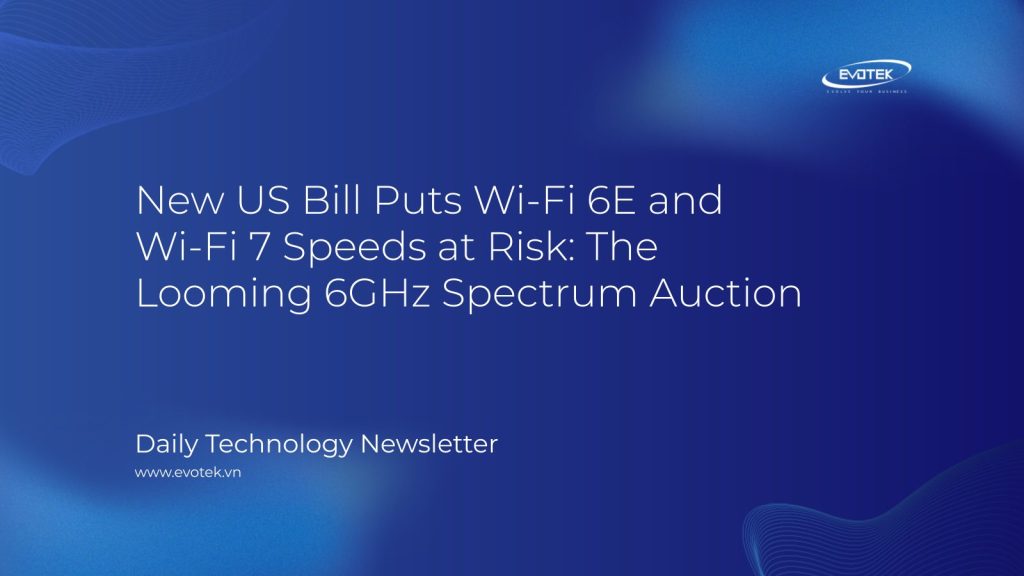A recently passed US budget bill, informally dubbed the “One Big Beautiful Bill (BBB),” contains a little-noticed provision that could significantly impact the future of high-speed Wi-Fi. While initial relief might have stemmed from the omission of AI regulation freezes tied to the $42.5 billion Broadband Equity, Access, and Deployment (BEAD) program’s funding, a deeper examination reveals clauses that empower the Federal Communications Commission (FCC) to auction off substantial segments of the 6GHz spectrum – a band crucial for modern, unlicensed Wi-Fi use.
This development is unwelcome news for users of cutting-edge Wi-Fi 6E and Wi-Fi 7 equipment. Devices like the Netgear Orbi 970, which leverage the 6GHz band, currently deliver impressive speeds of up to 2Gbps, significantly transforming home and office wireless connectivity.
A growing array of popular consumer electronics depends on the 6GHz band to unlock the full potential of Wi-Fi 6 and 7. This includes newer Apple iPhones, Samsung Galaxy and Pixel devices, recent MacBooks, iPads, Xbox Series X and S consoles, and Lenovo ThinkPads.
Opened for unlicensed use in 2020, the 6GHz band (spanning from 5.925 to 7.125 GHz) has become indispensable as demand for robust wireless connectivity soars in homes, businesses, and public spaces. While its indoor range is limited to about 50 feet with clear line of sight, its high capacity makes it ideal for dense environments.
So, why are cellular companies interested in this dedicated Wi-Fi spectrum? The Global System for Mobile Communications Association (GSMA), a powerful global mobile network operators’ trade association, asserts that the 6GHz band is “necessary for 5G to flourish and meet demand by 2030.”
However, not all mobile carriers are in agreement. AT&T CFO Pascal Desroches recently indicated at a tech conference that while more spectrum is generally beneficial, “there is no pressing need that I feel like we have to go out and acquire spectrum in the next 12, 24, even 36 months.”
Despite this nuanced view from some carriers, the BBB, with backing from former President Trump and championed by Senator Ted Cruz, effectively removes prior safeguards that protected the 6GHz band from exclusive, licensed mobile carrier auctions. This could compel the FCC to sell off as much as half of this vital unlicensed spectrum.
This marks a significant reversal from just five years ago. In 2020, the then-Trump-dominated FCC allocated the entire 1,200 megahertz of the 6GHz band for Wi-Fi use. Curiously, Ajit Pai, the former FCC head who championed that move, now as CEO of CTIA (the US telecom lobbying group), argues that mobile networks are in greater need of this spectrum.
Pai states: “Establishing a robust 800 megahertz pipeline of mid-band spectrum with a specific time frame for action is critical to meeting growing consumer demand, securing US leadership in 5G, and strengthening national and economic security.”
Pro-Wi-Fi organizations, most notably the Wi-Fi Alliance, strongly disagree. They contend that reallocating the 6GHz band would severely impede Wi-Fi’s continued evolution and negatively impact millions of consumers who rely on fast, dependable wireless connections for work, education, and entertainment.
In a direct appeal to lawmakers, the Alliance emphasized: “The 6GHz band constitutes the foundation for Wi-Fi’s continued development and growth because the band’s characteristics are perfectly suited to indoor networking that is the hallmark of Wi-Fi, while being flexible enough to support targeted outdoor uses. In locations ranging from small businesses and homes to stadiums, hospitals, schools, wearables, and advanced manufacturing, Wi-Fi is the workhorse of the internet.”
Be that as it may, the immediate consequence for users appears clear: sometime within the next year, a substantial portion of the 6GHz bandwidth is likely to be auctioned to the highest bidder. For homes and businesses, this could translate into noticeably slower and less reliable Wi-Fi, particularly in crowded environments where the 2.4GHz and 5GHz bands are already saturated.
Paradoxically, while the argument for auctioning this band is often framed around accelerating 5G, actual deployment of new mobile network bandwidth is a lengthy process. Therefore, significant improvements in mobile speeds from 6GHz usage are unlikely to materialize within the 2020s. In essence, a legislative move designed with broader budgetary goals could inadvertently compromise the very infrastructure that powers our increasingly connected lives, impacting the cutting-edge performance promised by Wi-Fi 6E and Wi-Fi 7.

 日本語
日本語 한국어
한국어 Tiếng Việt
Tiếng Việt 简体中文
简体中文